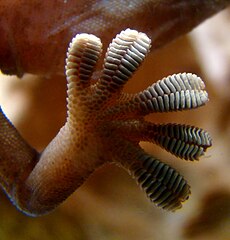Have you ever seen a gecko or lizard on a vertical 90 degree surface, and wondered how they are able to stick to the wall? In fact, it is not because of any type of gluey substance or sticky secretions. According to a recent article, biologists have been able to figure out exactly how a gecko can stay on a wall without slipping. Scientists have even been able to utilize
Doctoral Alfred Crosby at UMass Amherst commented that a gecko’s feet can attach and detach from a surface with ease without any residual sticky material being left over. Properties such as high capacity, reversibility, and dry adhesion that geckos use to adhere to surfaces, allow for a wider range of ideas for synthetic materials with similar traits of gecko feet. Moreover, Crosby says that Geckskin uses many of these properties to achieve a drastic result; Geckskin can hold up to 700 pounds while only being the size of an index card. This is amazing considering the fact that this small piece of synthetic material can hold up to the equivalent of seventeen 42 inch flat screen TVs on a flat vertical surface. Although having impressive adhesive ability, Geckskin can also be used a series of times without losing its overall effectiveness and stickiness.
Geckos were once thought to get their amazing adhesive properties only from microscopic hairs only their feet called setae. However, much of the gecko’s “stickiness” comes from other complexities on the foot such as specialized bones, tendons, and skin that work along with setae in order to produce those viscous properties. Geckskin combines all of these complexities to form a synthetic tendon made out of stiff fabric and a special weave in order to maximize surface area and contact. Generally, Geckskin be made relatively cheaply and can have many different uses in the home or in the work place. What uses for Geckskin can you think of?


Leave a Reply